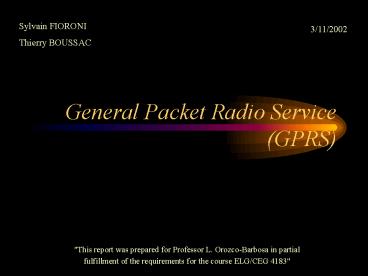General Packet Radio Service GPRS - PowerPoint PPT Presentation
1 / 26
Title:
General Packet Radio Service GPRS
Description:
Gp interface to other GPRS PLMN. Gi interface to other PSDN : ... Gn, Gp Interface : Based on TCP/UDP/IP. lower layers not specified(1) TCP X25, UDP IP ... – PowerPoint PPT presentation
Number of Views:1538
Avg rating:3.0/5.0
Title: General Packet Radio Service GPRS
1
General Packet Radio Service (GPRS)
Sylvain FIORONI Thierry BOUSSAC
3/11/2002
- "This report was prepared for Professor L.
Orozco-Barbosa in partial - fulfillment of the requirements for the course
ELG/CEG 4183"
2
Outline
- Context of GPRS
- Architecture
- Functioning
- Future trends
3
Context of GPRS
4
Data transmission in wireless networks
- Key point of next generations cellular networks
- GSM uses CSD technology (Circuit Switched Data)
- 9.6 kb/s bandwidth1
- Essentially text application
- web browsing, WAP, SMS
5
3G networks
- 3G UMTS
- 384 kb/s 2Mb/s
- Multimedia applications videoconference
- Very expensive(1)
- Technology not yet ready(2)
- Need for a smooth transition ?
- 2.5 G Networks
6
2.5G Networks
- HSCSD High Speed Circuit Switched Data
- GPRS General Packet Radio service
- EDGE Enhanced Data rates for Global Evolution
7
Architecture of GPRS
8
GPRS General Packet Radio service
- Uses packet switching
- Dynamic Timeslot allocation
- Up to 8 timeslots in each direction
- 4 new coding schemes to reduce error control
coding upon a sufficient link quality - theoretical throughput
- 8 timeslots, CS4 21.4kb/s gt 821.4171.2 kb/s
- actually, only CS2(1) available gt 813.4107.2
kb/s
9
GPRS architecture
10
GPRS Components
- SGSN (Serving GPRS Support Node)
- Equivalent to MSC in GSM
- GGSN (Gateway GPRS Support Node)
- Equivalent to GMSC in GSM
- PCU (Packet Coding Unit)
- Fragmentation of the packets into radio blocks
11
GPRS interfaces
- GPRS Core Network IP based network(1)
- Gn interface between xGSNs
- Gp interface to other GPRS PLMN
- Gi interface to other PSDN
- Internet, Wap Gateway, Enterprise LANs
- GPRS Access Network
- Gb interface from SGSN to PCUs
- Based on Frame Relay
- PCU-BSC proprietary interface
- Called A-ter, A-bis GPRS, A-GPRS(2)
12
GPRS interfaces
- Signaling Interfaces to GSM network(SS7 based)
- Gr interface from SGSN to HLR
- Gs interface from SGSN to MSC/VLR
- Gd interface from SGSN to GMSC
- Gc from GGSN to HLR
- Gf from SGSN to EIR
13
GPRS protocol stack
14
GPRS protocol stack
- Gb Interface
- Network Service part of frame relay network
(defines end to end virtual circuits NSVC(1)) - BSSGP (BSS GPRS Protocol)
- routing to cells (Virtual Channels BVC)
- flow control for each cell and mobile station(2)
- LLC (Logical Link Control)
- Very similar to HDLC
- Ciphering
15
GPRS protocol stack
- Gb interface
- SNDCP (Sub Network Dependent Converging Protocol)
- encapsulation of IP/X25 packets over lower layers
- Compression
- Signalling
- GMM (GPRS Mobility Management) Attach, Routing
Area Update procedures - SM (Session Management) PDP Context Activation
16
GPRS protocol stack
- Gn, Gp Interface
- Based on TCP/UDP/IP
- lower layers not specified(1)
- TCP ? X25, UDP ? IP
- GTP (GPRS Tunnelling Protocol)
- Encapsulation of packets over lower layers
- mainly security function
- Signaling functions
17
Functioning
18
Mobile Classes
- Class A
- can be attached simultaneously to GSM and GPRS
- can transmit voice and data at the same time
- Class B
- can be attached simultaneously to GSM and GPRS
- can transmit voice or data
- Class C
- cannot be attached simultaneously to GSM and GPRS
19
Attach procedure
20
PDP Context activation
21
PDP Context activation
193.148.25.89
22
QoS Management
- Specification of the requested QoS on PDP context
activation - Peak throughput
- Mean throughput
- Precedence priority on MAC layer
- Reliability Functioning mode of LLC, RLC and
GTP - Delay responsibility of the operator
Parameters of leaky bucket algorithm in BSSGP
23
Future trends
- UMTS ?
- experiences a lot of delay
- licence issue
- very expensive, technology not ready
- Real need for high rates on mobile networks?
- Competition with local networks
- GPRS and 2.5G can be a good compromise
- may last longer than it was supposed to(2)
24
Conclusion
- Is there a real need for data on cellular
networks now ? - currently too expensive Mobile terminals,
Utilization fees - relative failure of WAP
- High competition with wireless LANs
- still waiting for a killer application
25
References
- 1 ETSI 3GPP TS 03.60, Digital cellular
telecommunications system (Phase 2) General
Packet Radio Service (GPRS) Service description
Stage 2, version 7.7.0 Release 1998 - 2 ETSI 3GPP TS 08.18, Digital cellular
telecommunications system (Phase 2) General
Packet Radio Service (GPRS) Base Station System
(BSS) - Serving GPRS Support Node (SGSN) BSS GPRS
Protocol (BSSGP), version 8.9.0, Release 1999 - 3 ETSI(3GPP 03.6, Digital cellular
telecommunications system (Phase 2)General
Packet Radio Service (GPRS)Overall description
of the GPRS radio interfaceStage 2, version
8.9.0 Release 1999 - 4 Georgios Karagiannis, QoS in GPRS, Ericsson
open report 5/0362-FCP NB 102 88 Uen, 2000-12-21 - 5 Xavier LAGRANGE, Philippe GODLEWSKI, Sami
TABANNE, Réseaux GSM - DCS des principes à la
norme,Paris, HERMES, 1995
26
Questions
- What are the three 2.5G networks ?
- Why is the theoretical maximum throughput of GPRS
unreachable ? - What are the 5 parameters of QoS defined in GPRS
? - What are the nodes that have been introduced with
GPRS ? - What is GTP ?































